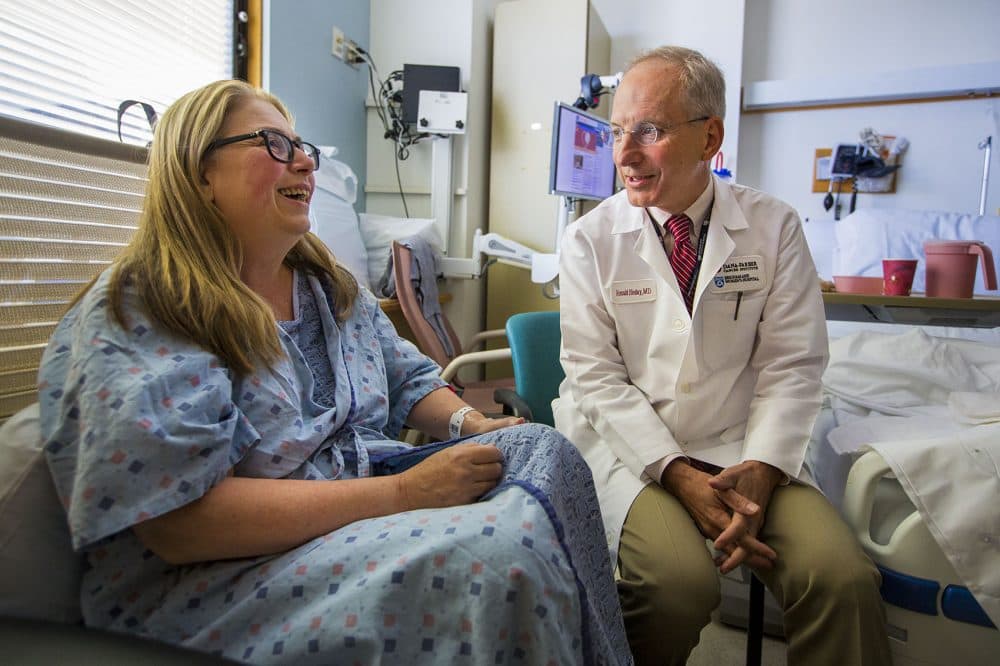Advertisement
Drink, Have An Operation, Chew Gum, Go Home: A Whole New Approach In Surgery
Resume
Julie Waldman sits in a chair next to her bed at Brigham and Women's Hospital, just about 30 hours after surgeons cut into her colon to relieve a severe case of diverticulitis.
"I've been up, I did a few laps [around the ward]," Waldman says with a chuckle, making a small circle in the air with her finger.
Waldman is impressed with her own progress. She had shoulder surgery a few years ago and "was very nauseous afterward, I was vomiting, and I didn't have any of that this time," Waldman says.
"The difference in surgeries is marked," adds Waldman's husband, Neal. "When she came back from surgery a few years ago she was bloated, she was loopy. This time -- with a more major surgery — she came right to [the] room, she was not bloated, she was able to walk really quickly. So I believe in this -- I think it was amazing."
"This" is a set of guidelines developed in Europe about 10 years ago, called Enhanced Recovery After Surgery (ERAS). Waldman's surgeon, Dr. Ron Bleday, says it's transforming surgery practices that have been in place for 50 years, beginning with how patients prepare for the procedure.
"The old rule was nothing to eat or drink after midnight," Bleday says. "So if you had a 3 o’clock operation, you as a patient were essentially in starvation mode."
Now, patients continue to drink until two hours before surgery, preferably a clear liquid with carbohydrates. (The stomach can clear this drink quickly, without risk of vomiting and choking.)
Hydrated patients don't need as much fluid during surgery -- the second major ERAS change. A patient in recovery is less bloated, wounds are less likely to get infected, and there's less stress on the heart.
The third change is no narcotics — or only as a last resort.
Bleday says narcotics are akin to poison. "In [the] hospital, narcotics slow down the gut; they also cause delirium and then a person can get hooked on narcotics if they’re on them too long," he says. "So we emphasize non-narcotic approaches, and that has made a huge difference."
Patients who are less delirious can sit up, if not walk, a few hours after surgery, which speeds their recovery.
A 2014 ERAS pilot of colorectal patients at the Brigham found lower rates of complications after surgery. Bleday says cardiac events dropped by as much as 90 percent, there were 66 percent fewer surgical site infections, and patients left the hospital two days earlier, on average. (Waldman left the evening after her surgery.)
The ERAS model is not better on all measures, the pilot found, and some surgeons are skeptical, worried about "running patients dry" with about half the traditional amount of fluid used during an operation.
But the Brigham is expanding ERAS guidelines to at least three other departments, and most other Partners HealthCare hospitals are at least testing the protocols.
"I’ve been in practice 25 years and so I just," Bleday says, struggling to find the right words, "I feel just, why didn’t we do this earlier?"
Bleday heard about Enhanced Recovery After Surgery four years ago, when a Danish surgeon spoke at the Brigham. Persuading some doctors and nurses to change may be difficult.
"I think it’s more dogma to tell you the truth," says Dr. Robin McLeod, a surgeon in Toronto. "It’s been the way it has been forever."
McLeod studied adoption of ERAS guidelines at 15 hospitals in Ontario. The adoption rate ranged from 20 to 100 percent. McLeod says the main problem is communication -- making sure everyone agrees to the same plan and explains it to the patient.
"So if myself as a surgeon said, 'Mrs. Brown, you’re going to go home in three days and then they go to our pre-admission unit' and the nurse says, 'Are you kidding? You’re not going to be able to go home for a week' and patients think, oh well, what should I be doing?" McLeod says.
Some elements of enhanced recovery -- drinking fluids closer to the time of surgery, and moving soon after -- have been studied and promoted. ERAS establishes a package of changes that supporters say is spreading quickly across the world.
"The need for change is becoming very obvious," says one of the movement's co-founders, Olle Ljungqvist, a professor of surgery in Sweden. "We need to produce better care at a lower cost and this is a way of doing that."
At the Brigham, Bleday estimates the hospital has saved more than $2 million in shorter patient stays.
But, patients following the ERAS protocols do have to supply their own gum.
Wait... gum?
Neal Waldman wonders why he was sent out to buy a selection for his wife. "The gum is interesting, tell us about the gum," Neal Waldman says to Dr. Bleday.
"The action of chewing gum mimics eating, which then stimulates the gut to wake up," Bleday replies.
So chewing is required, three times a day, immediately following surgery. Bleday encourages patients to go sugar free, but the effect is the same. Spearmint seems to be the most popular flavor, so far.
This segment aired on August 3, 2016.
